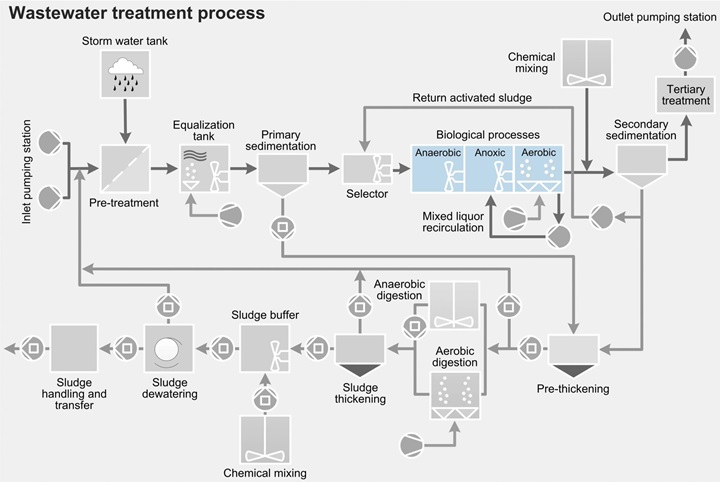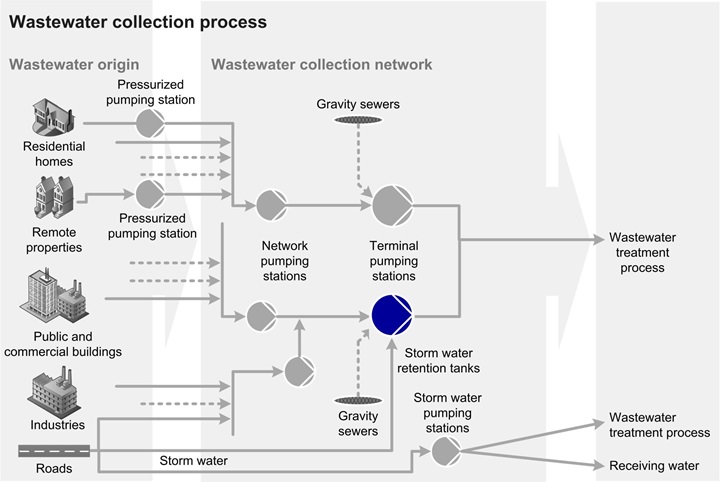- Easily installed, stand-alone or portable with optional fixed installation
- Reduces odors and septic conditions
- Cost-effective installation
- Self-aspirating—no need for compressed air
- Operates irrespective of water level variation
- Very low noise level, no aerosol formation, and no sedimentation on the bottom, thus minimizing environmental effects
Aerator type ABS Venturi jet
Small size mixing and aeration
Based on the ejector principle, the Venturi jet aerator is an ideal solution for smaller tanks and small treatment plants. It provides cost-effective mixing and aeration in municipal and industrial wastewater applications, storm water retention tanks, and balancing tanks.
- Combined aeration and mixing of wastewater in small and medium-sized tanks
- Municipal and industrial wastewater applications
- Storm water retention tanks, and balancing tanks
Main design features
- Premium Efficiency IE3 motors from 1.3–18.5 kW
- Air throughput of 50– 550 Nm3/h (33–330 SCFM)
- Depth range of 1.5–6.0 m (5 – 20 ft)
Key characteristics
| Maximum water circulation | 500 m3/h (2,500 US gpm) |
| Maximum air throughput | 550 m3/h (330 SCFM) |
Applications
-
Biological processThe target of the biological process in wastewater treatment is to remove organic, biodegradable substances via the metabolism of microorganisms and related biochemical processes.
-
Copper applicationsMaximize efficiency and durability in copper applications, while reducing energy costs and water consumption. With an advanced selection of materials for a comprehensive portfolio, Sulzer ensures reliable performance at minimized downtime, even in demanding environments.
-
EqualizationThe task of mixing in the equalization process is to blend the wastewater in order to prevent sedimentation, stratification and odor formation. It may also be necessary to mix and homogenize wastewater streams that arrive from different sources. Because the water level in the equalization tanks varies significantly and can sometimes be very low, high demands are placed upon the mixers.
-
Storm water retention tankStorm water retention tanks act as a buffer during periods of heavy rainfall. This is increasingly important as areas become more developed, with hard surfaces such as roofs, roads and parking lots that cannot absorb the rainwater. When storm water retention tanks are implemented, gravity or pumps can be utilized to provide a reduced continuous flow into the sewer system. Sulzer expertise makes it possible to avoid peak hydraulic loads and to limit the stresses on existing sewer systems.
-
Tertiary treatmentTreated wastewater may occasionally require further treatment. Local discharge rules may pose strict limits that cannot be fulfilled by even the most effective process, or a higher quality of effluent may be requested for its reuse. When tertiary treatment is needed, various levels of filtration can be applied, including very fine filtration. Often, however, a final step of mixing and aeration is sufficient to achieve the target. When this is the case, Sulzer's submersible mixer types ABS XRW and RW can be used, along with submersible aerator type ABS TA–TAK and disc diffuser system types ABS PIK, DS and Sucoflow.
Case studies and articles
-
Delivering cost savings for wastewater treatmentAir is one of the most important elements used in wastewater treatment processes. Activated sludge systems require proper aeration of the wastewater to ensure the biological decomposition of organic compounds. However, while air costs nothing, the systems required to deliver it can account for 50 to 90% of the energy consumption of a plant. Therefore, the decisions made with respect to this equipment can have a significant impact on running costs.
-
Case studiesWherever fluids are pumped, mixed, controlled or applied, we are there. See how our solutions create value for customers and learn how we can make your pumping and mixing processes more efficient and profitable, safeguarding your production and ensuring lasting reliability.
Documents
Data sheets
Dimension drawings
Talk or write to our experts to find your best solution.







